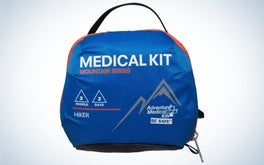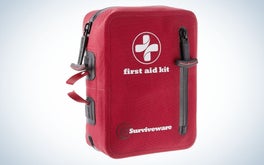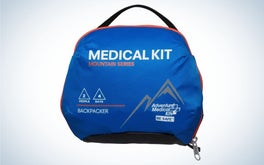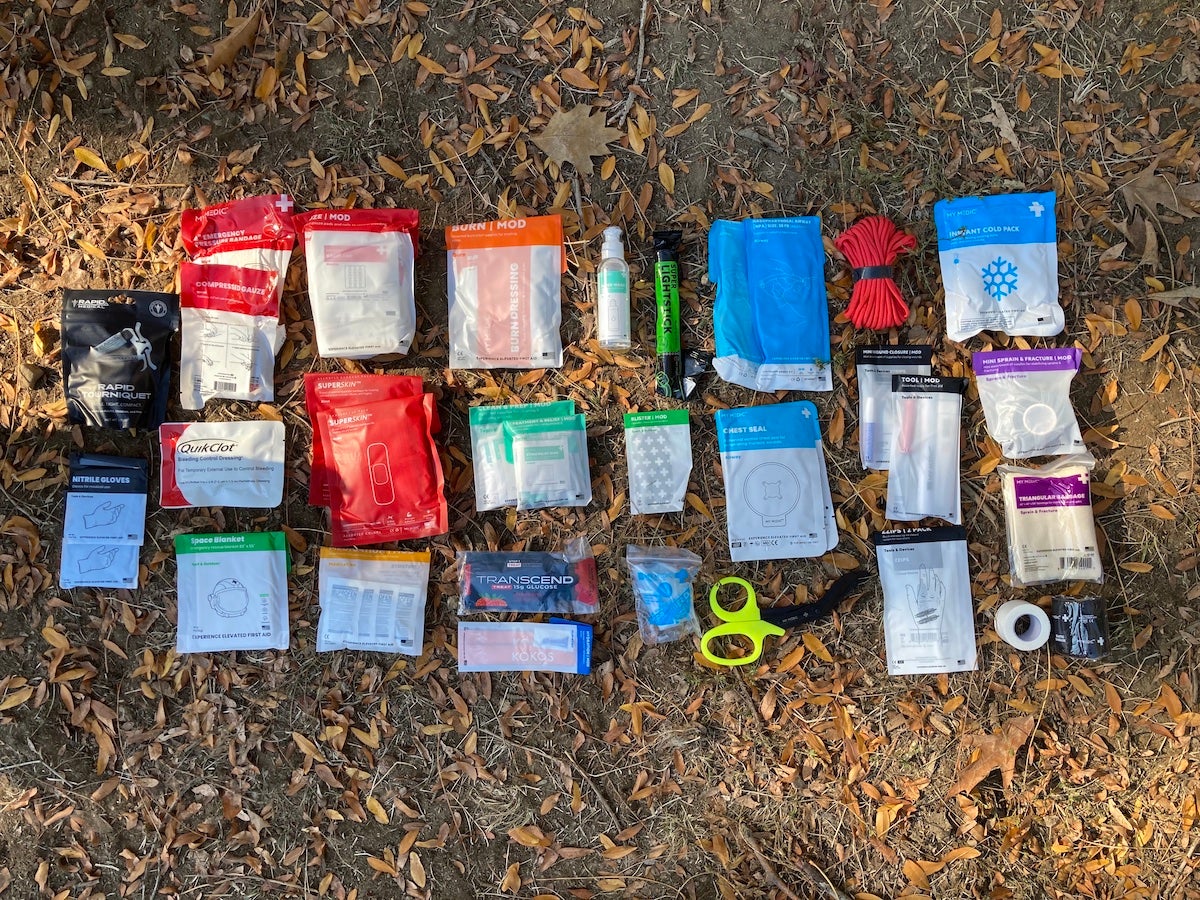| Best Overall |

|
Adventure Medical Kit Mountain Series Hiking | SEE IT |
LEARN MORE
|
Summary
The simple yet effective design provides the essentials and offers value for various activities. |
| Best for Day Hiking |

|
Surviveware Small | SEE IT |
LEARN MORE
|
Summary
This first aid kit is a useful and compact option to to keep in your day hiking bag for minor emergencies on the trail. |
| Best for Backpacking |

|
Adventure Medical Kit Mountain Series Backpacking | SEE IT |
LEARN MORE
|
Summary
This extensive first aid kit offers plenty of supplies for longer trips into the backcountry, making it a good choice for backpackers. |
We may earn revenue from the products available on this page and participate in affiliate programs. Learn more ›
A quality first aid kit that is stocked and ready for any event helps you feel safe and prepared no matter the adventure. Of course, a kit only gets you so far—you still need to know basic first aid skills. But having the right tools is essential to emergency medical assistance when you’re on the go, whether you’re camping, hiking, hunting, or even just out for a walk.
However, there isn’t a one-size-fits-all first aid kit for every activity. What you need for a day hike is different than what you’ll want to have on hand for a week or more in the backcountry. Knowing exactly what you need and what items are relevant in specific settings is a great starting point. Then, you can narrow down your top picks for the best first aid kits to fit your adventure needs.
- Best Overall: Adventure Medical Kit Mountain Series Hiking
- Best for Backpacking: Adventure Medical Kit Mountain Series Backpacking
- Best for Day Hiking: Surviveware Small
- Best for Survival: My Medic MyFAK
- Best for Cars: Road Warrior Standard Car Emergency Kit
- Best for Dogs: Kurgo Pet First Aid Kit
How We Picked the Best First Aid Kits
Part of the selection process for these first aid kits included knowledge of backcountry first aid. Much of it is innovation with what you have and the problem you are solving. While major accidents are less frequent, minor injuries occur all the time.

With all those things in mind, I chose the best first aid kits based on the following criteria:
- Carrying Case: When buying a pre-made first aid kit, the case needs to be durable, easy to pack, and a size that fits your needs. Since you’ll need to add, replace, and restock items from time to time, having a quality case should be a top priority.
- Contents: Do the contents fit the intended use? It doesn’t make much sense to buy a pre-made first aid kit and have to stock everything you need. I looked for kits that came with first aid essentials for the intended activity. Remember, those first aid items do expire after a while, and you will have to restock, but invest in a kit that has most of what you need to get started.
- Intended Use: What do you need this kit for? If you are backpacking, you may need different items than on a road trip or even a day hike. If you have your dog, they have different first aid needs. Know how and when you want to use your kit and tailor it accordingly.
Analysis of each company, first-hand experience with some kits, and verified customer reviews were also taken into consideration.
Best First Aid Kits: Reviews and Recommendations
Best Overall: Adventure Medical Kit Mountain Series Hiking
Specs
- Weight: 10 oz
- Dimensions: 6.5″ x 5.5″ x 3″
- Best Use: Hiking, short backpacking trips
- First Aid Book Included: Yes
Pros
- Relatively compact
- Easy to use book
- Affordable
- Great organization
Cons
- No CPR mask and limited trauma supplies
- Not good for big groups
The Adventure Medical Kit Mountain Series Hiking is an excellent value, and one of the best I’ve personally used out in the woods. It is easy to carry and includes all of the first aid essentials. Since it is a lightweight and compact design, it only provides enough supplies for two people for two days. If you are on a longer trip or with a larger group, a different kit may be of better use.
The interior of the carrying case has labeled pockets, making it easy to find things in an emergency. Their first aid handbook is included as well. While it includes the essentials, they are only in small quantities. If you get this kit, you may want to add a few more medications and extra bandages to ensure you have enough for the trip.

If you are looking for the best first aid kit for day hikes, weekend ventures, and more, this is one of my favorite options. It includes what you need for an affordable price, and there is room in the case to add a few additional items if desired. The only downside to this and any Adventure Medical Kits is that the carrying case is not durable. When using the guide series in the field, the zipper often would go out after a couple of months.
Best for Backpacking: Adventure Medical Kit Mountain Series Backpacking
Specs
- Weight: 13.4 oz
- Dimensions: 7″ x 6″ x 3.5″
- Best Use: Backpacking
- First Aid Book Included: Yes
Pros
- Very organized
- Includes essentials
- Works for small groups
- Affordable
Cons
- Carrying case isn’t waterproof
- Bag doesn’t allow for adding many other supplies
For backpacking trips or weekend hunts, the Adventure Medical Kit Mountain Series Backpacking first aid kit is a step above their Hiker version. While it includes many of the same useful items, including their first aid handbook, it can serve a small group for a longer period of time.
The bag is easy to carry, and similar to the other Mountain Series kits they have, it is well organized. It would be nice if the bag were a bit bigger to allow users to add more items, but most of what you need is included. If you feel more comfortable carrying more advanced trauma items, this pack may not suit you, but it will fit most backpackers’ needs.
Since the bag isn’t fully waterproof, we recommend packing it into the top of your pack so it remains accessible but won’t be as susceptible to precipitation.
Best for Day Hiking: Surviveware Small
Specs
- Weight: 14 oz
- Dimensions: 3.1″ x 6.2″ x 6.7″
- Best Use: Hiking, emergency kit
- First Aid Book Included: No
Pros
- Durable case
- Includes essentials
- Very compact
- CPR kit
Cons
- Small bag limites supplies
- No first aid handbook included
The Surviveware Small first aid kit is a fantastic purchase if you want a small but valuable kit. It includes all of the essentials, and comes with the removable CPR kit. The case is highly durable and waterproof, making it ideal for outdoor use in any climate.
Since this is their small version, it works best for individuals or small groups of people heading into the backcountry. If you have a larger group or are out for a longer trek, they also have a Surviveware Comprehensive kit.
The bag’s interior is well organized and labeled to make finding items you need a bit easier. Since the bag is so small, it can make it challenging to access some things, and there isn’t much room for any additional supplies. But overall, this kit is tiny but mighty and won’t let you down if you need it.
Best for Survival: My Medic MyFAK
Specs
- Weight: 31 oz
- Dimensions: 8” x 7” x 4.5”
- Best Use: Survival kit, emergency kit, motorsports
- First Aid Book Included: Yes (eBook only)
Pros
- Very comprehensive
- Durable case
- Excellent organization
Cons
- Expensive
- Bulkier than other options
If you want one of the best survival kits, check out the My Medic MyFAK Mini. Unlike many other kits on our list, this one includes a relatively comprehensive kit of trauma supplies. Since it is a burly first aid kit, it is heavier and bulkier than the rest, making it a less favorable option for backpacking. That said, I love it for day hikes or car camping.

It will be an ideal choice for a survival kit, emergency kit, motorsports, or if you are out with a large group. This kit pairs well with any activity that has a higher risk of trauma-related injuries. The MyFAK is the smallest option they offer, so if you need a more intensive kit, My Medic Pro is ideal for guides, groups, or extended ventures off the beaten path.
When you purchase the Pro kit, you also receive an hour-long first aid training on how to use the items in an emergency. In my opinion, the course is well worth purchasing the Pro kit. It offers in-depth information about how to use a tourniquet, pack a wound to control bleeding, how to use a chest seal, and much more.

The purchase of the MyFAK comes with a first aid handbook, but it is only in eBook form. I am not a huge fan of that format since it is hard to ensure it will be available when needed, especially if you’re in the backcountry. Hopefully, if you have this kit, you have or are with someone with more extensive first-aid knowledge. Better yet, use their course to get up to date on your first aid training.
Best for Car: Road Warrior Standard Car Emergency Kit
Specs
- Weight: 17 lbs
- Dimensions: 8” x 12” x 16”
- Best Use: Car travel, RVing, overland travel
- First Aid Book Included: No
Pros
- Full emergency kit
- Ideal for roadside emergencies
- More than just a first aid kit
Cons
- Heavy with all the equipment inside
- Not very easy to organize bag
While I was searching for the best first aid kit to keep in the car, I came to the conclusion that you don’t just need a first aid kit, but an emergency kit that includes one. The Road Warrior Standard Car Emergency Kit contains not only the first aid kit essentials, but it also includes tools, emergency blankets, a collapsible shovel, hand warmers, jumper cables, and more.
Whether you need to upgrade your old emergency kit for your car, need one for your offroading vehicle, or you have a child that is newly driving, this kit nearly has it all. If there are things you want to add to the kit, you can quite easily. The first aid kit included is small, but it has the basics for minor injuries. We recommend adding a few items to the first aid portion if you feel it isn’t comprehensive enough, but overall it is a quality kit.
Best for Dogs: Kurgo Pet First Aid Kit
Specs
- Weight: 14.5 oz
- Dimensions: 3.5” x 9” x 5”
- Best Use: Dog owners
- First Aid Book Included: No
Pros
- Compact, durable case
- Well organized
- Enough room to add a extra supplies
- Lifetime warranty
Cons
- A bit small, so if you have multiple dogs you’ll need more supplies
- No handbook
There are a vareity of first-aid items that could save your hunting dog, and many of the essentials are included in the Kurgo Pet First Aid Kit. The compact carrying case is easy to fit into a pack, and the roll-up design is on of my favorites. There is enough room in the kit to include other items for yourself and you can use it for you and your dog.
Although there would have been room in the kit, there isn’t a dog first aid handbook included. Since dog first aid can differ from human first aid, having a handbook would be nice in case of an emergency.
Overall, the kit has a lot of what you need, but adding in some ointment, hydrogen peroxide, and even a carrying sling for emergency transport would make it perfect.
What to Consider When Choosing a First Aid Kit
While it may not feel like it, there are several things to consider before buying a first aid kit. Before you jump down to discover our top picks for the best first aid kits, get to know your personal needs to help narrow down your search. That way, you’ll find the right kit, whether or not it is on our list.
Intended Use
Before you even start your research process, decide the intended use. Why do you need a first aid kit?
Are you going backpacking? Are you going hunting? Will your dog be with you?
Once you have identified the activity and reason for investing in a first aid kit, you can narrow down the type of kit that works the best.
Five things to consider when deciding if a kit fits your intended use and activity needs:
- Activity: Determining the activity this kit is for is important because your first aid needs will change pending your access to medical care. For instance, the best backcountry first aid kit includes some trauma medical gear because it will take longer to get medical attention. Then there are ultralight kits for trail running or a fully waterproof one for paddling. More comprehensive kits will be much larger but are easy to carry when car camping or RVing.
- Trip Length: Do you have enough first aid equipment in the kit for the time you’re gone? Always double-check the kit before you head out to ensure it is well stocked and ready for the estimated number of days and distance of travel.
- Area of Travel: Get to know the area you’re traveling through. Are there poisonous plants or venomous snakes in the area? Are there a lot of insects, or maybe ticks? Make sure the kit you have with you has the items needed to treat potential risks in that environment.
- Group Size: How many people are in your group? Not everyone in the group needs to carry a first aid kit. It is more common for one or two people to carry first aid supplies. Ensure that the kit you bring is comprehensive enough and has plenty of supplies to support the entire group’s needs—stock up on extra supplies like bandages and pain medication.
- Special Medical Needs: If you or anyone else has special medical needs, make sure the first aid kit contains supplies to support those needs. Conditions that require an EpiPen, glucose pills, an inhaler, or other prescription meds should be included in the kit and easily accessible at all times.
Keep in mind that you may not find a kit that fits all of your specific needs. In those cases, invest in a quality pre-made kit and add the missing supplies.
Your First Aid Training
Having a first aid kit to fit the activity is one thing. But if you don’t know how to use any of the items, that kit isn’t going to do much good. Not only do you want a quality, compact first aid kit, but you want to know how to treat common outdoor injuries with it.
I hope that if you’ve spent any length of time in the outdoors, you know at least some basic first aid. If you venture into the backcountry, I hope your knowledge is even more extensive. After working as a backcountry guide, I have seen even the most experienced and well-prepared adventurers get hurt. Knowing how to stabilize a person for transport is a must.
It is helpful to choose a kit that includes a first aid handbook, and we suggest you take the time to read it. Beyond that, it is far more beneficial to take a first aid class. Even an introductory course can teach skills that will apply to many situations, but outdoor-specific first aid classes may be more relevant when venturing into the wilderness.
Some general research is an excellent place to start, but we cannot stress enough how important having first aid training is, no matter the outdoor activity.
Pre-Made vs Building Your Own
Although there are plenty of pre-made first aid kit options, a common consideration is making your own. The benefit of a pre-made kit is that you already have most of what you need in a convenient package. Then, you can build out the kit to be more comprehensive from there.
Pre-made kits tend to be convenient and will save some time. Making your kit can get expensive, pending on the type of kit you are making. But pre-made kits can also feel overpriced so it is a fine balance. When putting a kit together, you’ll need to buy the carrying case and then each kit item. The primary benefit of making your own is that you can fully personalize it to your adventure needs.
Making a first aid kit makes more sense if you are traveling with a large group and can utilize bulk-bought supplies. If you are traveling solo, you can also make a kit from basic first aid supplies you may have in your home.
Outdoor Safety Essentials
Whether you decide to make your own or purchase one of the pre-made first aid kits we’ve reviewed below, get to know some outdoor safety essentials. Not all first aid kits will come stocked with the same items, but there are some basics they all should include.
Basic First Aid Essentials:
- Tools: blunt tip scissors, tweezer, nail clippers, razor or small knife, and small mirror
- Bandages: gauze, athletic or medical tape, blister treatments, and assorted adhesive bandages
- Medications: antidiarrheal pills, antacid tablets, prescription medications, ibuprofen, aspirin, rehydration salts
- Ointments: antibiotic ointment, burn cream, and hydrocortisone cream
- Other Items: antiseptic wipes, bee-sting kit, tick remover, splints, elastic wraps, and burn dressing
Having trauma equipment in the kit can be beneficial in backcountry or survival settings but isn’t always necessary. You can buy pre-made kits that have trauma supplies included. We also encourage you to invest in a kit with a reference guide. More comprehensive first aid books will overview basic first aid procedures, which can be helpful during an emergency. If a kit doesn’t come with a guide, you can purchase pocket guides to include.
Even if the kit you buy does not come with all the supplies you think you need; it should include the items listed above. Trip and need specific supplies may need to be purchased and added separately.
Also, consider that dogs need different medical treatment than humans in some circumstances. Dog-specific first aid items can be added to your existing kit, or you
FAQs
Q: Do first aid kits expire?
Yes, first aid kits do expire. Most pre-made first aid kits will have an expiration date of 2-5 years after the purchase. The individual items in the kit may also have expiration dates on them. Things like bandages and tweezers may not need to be replaced, but medications should be updated to ensure effectiveness.
Q: What should be in a camping first aid kit?
What should be in a camping first aid kit varies according to the type of camping you are doing and how remote you are. All first aid kits should have basic first aid supplies such as bandages of multiple sizes, antiseptic wipes, antibacterial ointment, gauze, nonstick pads, medical tape, after bite or anti-sting ointment, burn cream, tweezers, antihistamine, and ibuprofen. Many other items should be included in a first aid kit, and to learn more about first aid essentials, go back to the “things to consider before buying” section at the beginning of the article.
Q: How much does a first aid kit cost?
How much a first aid kit costs depends on how complex it is and what is included. Small, travel-sized first aid kits may be as cheap as 10 USD, while more complex first aid kits can be 200+ USD. The good news is that you can find decent first aid kits suitable for camping or backpacking at around 25-30 USD.
Q: Is it cheaper to make a first aid kit?
It can be cheaper to make a first aid kit if you can use all of the items within their time of expiration. The perk of pre-made kits is that they only include a set number of items and you can always replace commonly used items like bandaids. If you often travel with a big group where more first aid supplies are used, making your own is usually cheaper because you can buy and use bulk items efficiently.
Another reason why buying your own may be less expensive is if you buy a pre-made kit that is too complex for your needs. Many of us do not need overly complicated kits, nor do many people know how to use all of the supplies. We suggest taking a first aid course, buying a basic kit, and adding other items as needed.
Q: What should you look for in first aid kits?
What you should look for in first aid kits is a sturdy carrying case that fits your needs and some basic supplies. While it is nice to buy a fully stocked first aid kit, you will have to update and add a few things here and there. So, look for a case large enough to hold what you need, supplies that won’t need to be replaced (tweezers, handbook, etc.), and most of the first aid essentials to get you started.
Best First Aid Kits: Final Thoughts
- Best Overall: Adventure Medical Kit Mountain Series Hiking
- Best for Backpacking: Adventure Medical Kit Mountain Series Backpacking
- Best for Day Hiking: Surviveware Small
- Best for Survival: MyMedic MyFAK
- Best for Cars: Road Warrior Standard Car Emergency Kit
- Best for Dogs: Kurgo Pet First Aid Kit
The best first aid kits for camping have a durable easy-to-carry case and include all of the first aid essentials. You’ll also want room to add other supplies you may need. All of the kits on our list are great options for camping, hiking, and more. Still, there isn’t necessarily one that we can say will work the best for everyone. Since many readers like different types of camping, their first aid kit needs will differ.
Why Trust Us
For more than 125 years, Field & Stream has been providing readers with honest and authentic coverage of outdoor gear. Our writers and editors eat, sleep, and breathe the outdoors, and that passion comes through in our product reviews. You can count on F&S to keep you up to date on the best new gear. And when we write about a product—whether it’s a bass lure or a backpack—we cover the good and the bad, so you know exactly what to expect before you decide to make a purchase.







